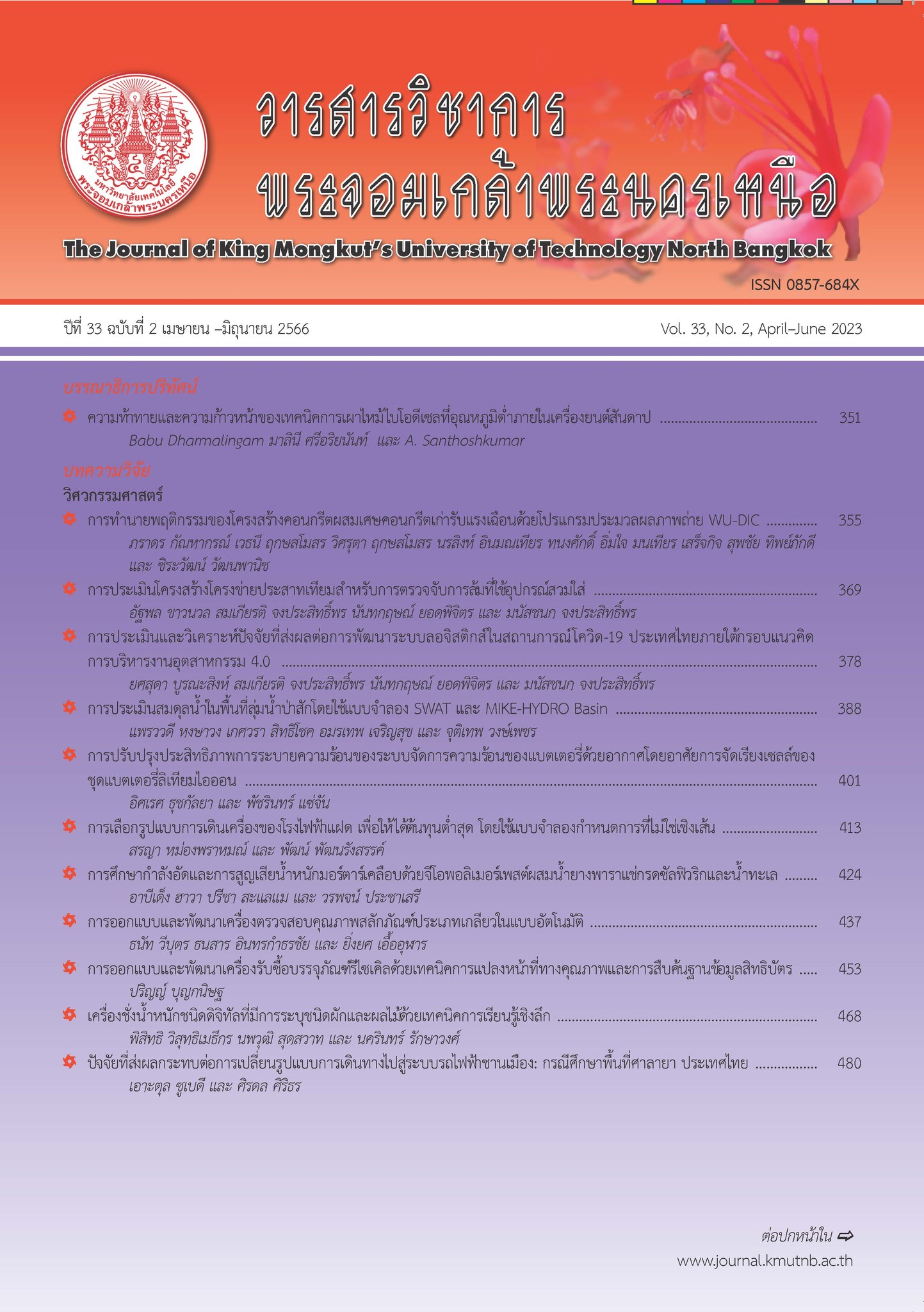การลดความสูญเสียที่เกิดจากการหยุดเดินเครื่องจักรโดยไม่ได้วางแผนล่วงหน้าในกระบวนการผลิตชิ้นส่วนเพลาด้วยการวัดประสิทธิผลโดยรวม
Main Article Content
บทคัดย่อ
การลดความสูญเสียที่เกิดจากการหยุดเดินเครื่องจักรโดยไม่ได้วางแผนล่วงหน้ามีความสำคัญต่อเวลาเดินเครื่องจักรและการเพิ่มประสิทธิผลโดยรวม ทำให้ลดต้นทุนความสูญเสีย งานวิจัยนี้จึงมีวัตถุประสงค์เพื่อเสนอแนวทางการลดความสูญเสียที่เกิดจากการหยุดเดินเครื่องจักรโดยไม่ได้วางแผนล่วงหน้าในกระบวนการผลิตชิ้นส่วนเพลา โดยใช้การวิจัยแบบผสมผสาน ซึ่งเก็บรวบรวมข้อมูลเชิงปริมาณด้วยแบบสอบถามกับกลุ่มตัวอย่าง 140 คน และข้อมูลเชิงคุณภาพด้วยการสังเกตแบบมีส่วนร่วม สัมภาษณ์เชิงลึก และสนทนากลุ่ม จากผู้ให้ข้อมูล 27 คน วิเคราะห์ข้อมูลด้วยกิจกรรมที่เพิ่มคุณค่าและไม่เพิ่มคุณค่า แผนผังสายธาร โมเดลสมการโครงสร้างเพื่อหาปัจจัยเชิงสาเหตุ ร่วมกับการวัดประสิทธิผลโดยรวม ผลการวิจัยพบว่า กิจกรรมกลึงชิ้นส่วนเพลาทำให้เกิดความสูญเสียจากการหยุดเดินเครื่องจักร โดยการวางแผนเป็นปัจจัยเชิงสาเหตุที่มีอิทธิพลต่อความสูญเสียที่เกิดขึ้น จึงได้เสนอแนวทางการลดความสูญเสียด้วยการวัดประสิทธิผลโดยรวม ทำให้เวลาในการหยุดเดินเครื่องจักรลดลงจาก 110.58 เป็น 52.24 นาทีต่อวัน ส่งผลให้ค่าประสิทธิผลโดยรวมของเครื่องจักรเพิ่มขึ้นจากร้อยละ 61.21 เป็นร้อยละ 86.24 ขณะที่ต้นทุนความสูญเสียลดลงจาก 5.26 เป็น 1.70 บาทต่อชิ้น ผู้วิจัยจึงเสนอให้ผู้ประกอบการให้ความสำคัญต่อการลดความสูญเสียที่เกิดจากการหยุดเดินเครื่องจักรโดยไม่ได้วางแผนล่วงหน้า ซึ่งเป็นประโยชน์ต่อการดำเนินงานต่อไป
Article Details

อนุญาตภายใต้เงื่อนไข Creative Commons Attribution-NonCommercial-NoDerivatives 4.0 International License.
บทความที่ลงตีพิมพ์เป็นข้อคิดเห็นของผู้เขียนเท่านั้น
ผู้เขียนจะต้องเป็นผู้รับผิดชอบต่อผลทางกฎหมายใดๆ ที่อาจเกิดขึ้นจากบทความนั้น
เอกสารอ้างอิง
V. Ravi, Theory of Machines. New Delhi: PHI Learning, 2011, p. 40.
W. Yongpisanphob. (2020, September). Business/ Industry Outlook 2020-16: Auto Parts Industry [Online]. Available: https://www.krungsri.com/ th/research/industry/industry-outlook/Hi-tech- Industries/Auto-Parts/IO/Industry-Outlook- Auto-Parts
Thansettakij. (2021, January). Insight into “Thai AutomotiveIndustry” 2021–2023 Opportunities for 4%. [Online]. Available: https://www.than settakij.com/content/motor/463939
Vutthipong Engineering and Service Part, Ltd., “Daily report,” Vutthipong Engineering and Service Part, Ltd., Khon Kaen, Thailand, 2020 (in Thai).
P. Suttikulsombat and P. Ruangchoengchum, “The loss reduction from downtime by improving overall equipment effectiveness and speed controlling in the offset printing process,” Journal of Accountancy and Management, Mahasarakham Business School, Mahasarakham University, vol. 12, no. 3, pp. 143–156, 2020 (in Thai).
S. Preangprom, S. Tumrongsuk, and W. Anuntajalerchork, “Increasing production efficiency by maintenance planning: A case study of a conveyor belt machine the receivingdistribution room,” The Journal of KMUTNB, vol. 30, no. 4, pp. 201–215, 2020.
P. Pornprasert, S. Karawek, K. Kittisuntaropas, and P. Boonrom, “An application of preventive maintenance principles to reduce the machine breakdown time in the handbag manufacturing: A case study in Thai Silk Industry Co., Ltd,” Thai Industrial Engineering Network Journal, vol. 3, no. 2, pp. 15–21, 2017 (in Thai).
F. K. De-La-Cruz-Arcela, J. S. Martinez-Castillo, E. Altamirano-Flores, and J. C. Alvarez-Merino, “Application of lean manufacturing tools to reduce downtime in a small metalworking facility,” presented at the IEEE International Conference on Industrial Engineering and Engineering Management (IEEM), Macao, China, Dec. 15–18, 2019.
R. Wolniak, “Downtime in the automotive industry production process-cause analysis,” Quality Innovation Prosperity, vol. 23, no. 2, pp. 101–118, 2019.
Y. Yin, Y. Wang, T. C. E. Cheng, and J. Li, “Parallelmachine scheduling of deteriorating jobs with potential machine disruptions,” Omega, vol. 69, pp. 17–28, 2017.
Y. Yin, T. C. E. Cheng, and D. J. Wang, “Rescheduling on identical parallel machines with machine disruptions to minimize total completion time,” European Journal of Operational Research, vol. 252, no. 3, pp. 737–749, 2016.
A. Tashakkor, R. B. Johnson, and C. Teddlie, Foundations of Mixed Methods Research, 2nd ed. New York: Sage, 2020, p. 101.
R. Kanjanapanyakom, Industrial Work Study. Bangkok: Top Publishing, 2019 (in Thai).
R. B. Kline, Principles and Practice of Structural Equation Modeling, 4th ed. New York: The Guilford Press, 2015, p. 16.
U. Sekaran and U. Bougie, Research Methods for Business: A skill-building approach, 7th ed. Handdington: John Wiley and Sons, 2016, pp. 113.
R. B. Khanna, Production and Operations Management. Delhi: PHI Learning Private, 2015, p. 122.
S. Bell, Run Grow Transform: Integrating Business and Lean IT. New York: CRC Press, 2017, pp. 24–25.
P. L. King and J. S. King, Value Stream Mapping for the Process Industries: Creating a Roadmap for Lean Industries. Florida: CRC Press, 2017, pp. 96–98.
N. Blunch, Introduction to Structural Equation Modeling Using IBM SPSS Statistics and Amos. London: Sage, 2012, p. 294.
M. R. R. Adam, A Practical Guide of the Integrated SEM (Structural Equation Modeling) with Lisrel & Amos for Marketing & Social Sciences. Yogyakarta: Deepublish Publisher, 2018, p. 102.
K. Singh, M. Junnarkar, and J. Kaur, Measures of Positive Psychology: Development and Validation. New Delhi: Springer, 2016 pp. 28–29.
D. H. Stamatis, The OEE Primer: Understanding Overall Equipment Effectiveness, Reliability, and Maintainability. New York: CPR Press, 2017, pp. 39–41.
L. Hassani and G. Hashemzadeh, “The impact of overall equipment effectiveness on production losses in Moghan cable & Wire manufacturing,” International Journal for Quality Research, vol. 9, no. 4, pp. 565–576, 2015.
S. C. Nwanya, J. I. Udofia, O.O. Ajayi, and T. Peng, “Optimization of machine downtime in the plastic manufacturing,” Cogent Engineering, vol. 4, no. 1, pp. 1–12, 2017.
P. Boonrod and P. Klomjit, “Efficiency improvement for powder coating process in brake lining factory,” Journal of Engineering, RMUTT, vol. 18, no. 1, pp. 1–12, 2020 (in Thai).
C. Maksuk, S. Thepchit, and S. Srikijsuwan, “Business development model for metal part manufacturing for the aerospace industry,” Journal of KMUTNB, vol. 30, no. 1, pp. 170–181, 2020 (in Thai).
T. Rattanakool, “Total productive maintenance for improving overall equipment effectiveness in steel manufacturing,” Industrial Technology Lampang Rajabhat University Journal, vol. 10, no. 1, pp. 50-62, 2017 (in Thai).
Z. Ales, J. Pavlu, V. Eagat, F. Mosna, and V. Jurca, “Methodology of overall equipment effectiveness calculation in the context of industry 4.0 environment,” Maintenance and Reliability, vol. 21, no. 3, pp. 411–418, 2019.
A. Fauzi and G. Doloksaribu, “Efforts in improving overall equipment effectiveness (OEE) of weaving machine in tire cord division at tire manufacturing company in Indonesia,” International Journal of Science and Research, vol. 5, no. 7, 2016, Art. no. 7303735.
A. Hadgaonkar, S. Sapkal, and A. Arora, “Downtime reduction of end of line pump testing machine,” Proceedings of International Conference in Mechanical and Energy Technology, 2020, pp. 145–156.
T. Prasertrungruang and B. H. Hadikusumo, “Study of factors influencing the efficient management and downtime consequences of highway construction equipment in thailand,” Journal of Construction Engineering and Management, vol. 135, no. 1, pp. 2–11, 2009.

